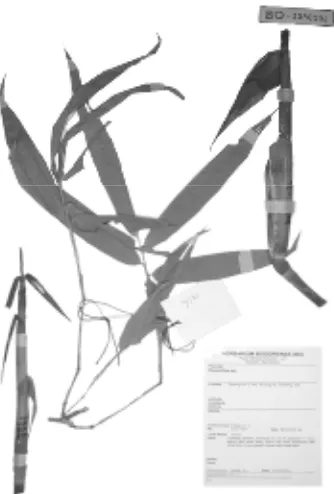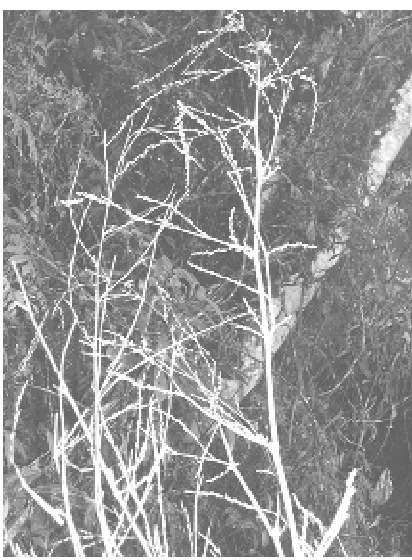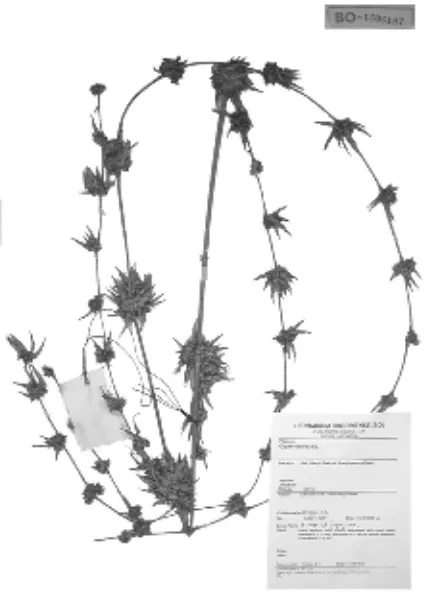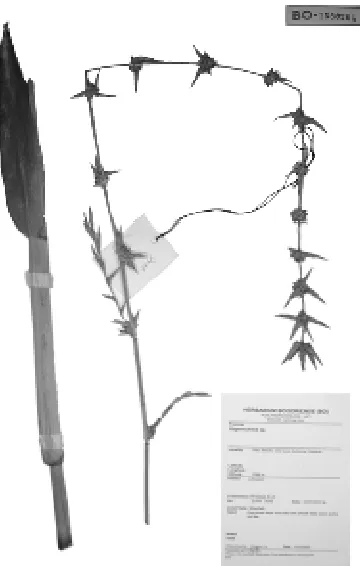A JOURNAL ON TAXONOMIC BOTANY,
PLANT SOCIOLOGY AND ECOLOGY
REINWARDTIA
A JOURNAL ON TAXONOMIC BOTANY, PLANT SOCIOLOGY AND ECOLOGY Vol. 12(2): 129-204.22 November 2004
Editors
ELIZABETH A. WIDJAJA, MIEN A. RIFAI, SOEDARSONO RISWAN, JOHANIS P. MOGEA
Correspondence and subscriptions of the journal should be addressed to
REINWARDTIA Vol 12, Part 2, pp: 199 – 204
NEW SPECIES OF BAMBOOS (POACEAE-BAMBUSOIDEAE) FROM
BALI
ELIZABETH A. WIDJAJA,
Herbarium Bogoriense, Botany Division, Research Centre for Biology, LIPI, Bogor, Indonesia
INGGIT PUDJI ASTUTI
Bogor Botanical Garden, Centre for Plant Conservation, Bogor, Indonesia
& IDA BAGUS KETUT ARINASA
Ekakarya Botanical Garden, Bali, Indonesia
ABSTRACT
WIDJAJA, E.A., ASTUTI, I. P., ARINASA, I. B. K. 2004. New species of bamboos (Poaceae-Bambusoideae) from Bali. Reinwardtia 12(2):199 - 204. Five new species of bamboos from Bali are described: Bambusa ooh, Dinochloa sepang, Gigantochloa aya, Gigantochloa baliana and Gigantochloa taluh in the context of a proposal field guide to Balinese bamboos. Description including the distribution and the vernacular names are provided.
Keywords: Bamboo, Bali, Bambusa ooh, Dinochloa sepang, Gigantochloa aya, Gigantochloa baliana, Gigantochloa taluh.
ABSTRAK
WIDJAJA, E.A., ASTUTI, I. P, ARINASA, I. B. K. 2004. Jenis baru bambu di Bali. Reinwardtia 12(2): 199 - 204. Lima jenis baru bambu dari Bali diusulkan yaitu Bambusa ooh, Dinochloa sepang, Gigantochloa aya, Gigantochloa baliana, Gigantochloa taluh dalam mempersiapkan panduan lapangan Bambu di Bali. Pertelaan termasuk persebaran dan nama daerahnya juga dikemukakan.
Kata kunci: Bambu, Bali, Bambusa ooh, Dinochloa sepang, Gigantochloa aya, Gigantochloa baliana, Gigantochloa taluh.
INTRODUCTION
Of the bamboos occurring in Indonesia, 37 species so far have been discovered in Bali, nine of which could not be identified (Widjaja, Astuti, Arinasa & Sumantera, 2004), as without flowering material identification of bamboos is usually impossible. No overall review of Balinese bamboos has been published, although several species have been mentioned in various reports (Arinasa & Widjaja 2003). We aim to prepare a general field guide for which the present publications is a precursor.
Recently, four species of the unknown taxa have come into flower making identification possible. One species of Bambusa not previously collected and still only known in the sterile state appears to be sufficiently distinct to allow description.
Flowering material of the four remaining species hopefully will become available soon so that the field guide can be completed.
With the new species Dinochloa sepang, Dinochloa is a new generic record for Bali. Although the Balinese flora is closely related to Javanese one, many species appear to have a very local distribution. Gigantochloa appears to be more diverse in Bali then in Java, and some species appear to be common and have a high usage in Bali. The new species were found in the Bangli District where bamboo community gardens occurs.
Bambusa oohWidjaja & Astutisp.nov. – Fig.1 & 2.
Culmi vagina foliolo trainglari erecto extus pubescenti. ⎯ Type: Bali, Karangasem, Ida Bagus K. Arinasa 4499 (BO – Holotype; K, Ekakarya Botanical Garden – Isotype).
Young shoot green, covered with brown hairs.
200 REINWARDTIA [VOL.12
Culm erect, green, internode 25 – 75 cm, diameter 10 cm at breast height.
Fig. 1. Culm sheath of Bambusa ooh Widjaja & Astuti. Picture from Arinasa 4499.
Fig. 2. Bambusa ooh Widjaja & Astuti. Picture from
Arinasa 4499.
Culm sheath tardily caducous, covered by brown hairs, auricle rounded up to 8 mm tall, with 2.5 – 3.7 cm wide with c. 2 cm long bristles,
ligule laciniate, irregular, 3 – 4 mm high, with a few up to 8 mm long bristle; blade erect, triangular, outer part dark brown hairs.
Leaf blades lanceolate, 12 – 30 x 2.5 – 4 cm, covered with scattered light brown hairs, auricle rounded, 1 mm high with 1.5 mm in lateral extent, with few bristle 3 – 4 mm long.
Inflorescence not seen.
DISTRIBUTION: Rendang, Karang Asem, Bali.
VERNACULAR NAME: tiing ooh.
SPECIMEN EXAMINED. Bali, Karang Asem, Rendang, Ida Bagus Ketut Arinasa 4499 (BO, K, Ekakarya Botanical Garden).
Dinochloa sepang Widjaja & Astuti sp.nov. ―
Fig. 3, 4 & 5.
Dinochloa matmat et D. scandenti similis, culmi foliola basi pubescentia auriculae desunt, ligula setis irregularibus tenuibus, foliolum deflexum. Pseudo-spiculae ad 4 mm longae uniflorae, glumae lemmaque apice breviter mucronato, antherae 6 magenteae, fructus obovoideus. ⎯ Type: Bali, Buleleng, Sepang,
EAW 7561 (BO – holotype, K, L – Isotype).
Fig. 3. Dinochloa sepang Widjaja & Astuti. Picture from EAW 7561.
2004] E.A. WIDJAJA et.al.: New species of bamboos from Bali 201
Culms climbing, internodes 15.3 – 23 cm long, 0.6 – 3 cm diam., thick wall, above the node pubescent, gradually less so toward the apex, hairs white to light brown, with up to 11 lateral branches.
Fig. 4. Inflorescence of Dinochloa sepang Widjaja & Astuti. Picture from EAW 7561.
Culm leaves covered by white wax, at the base with brown hair; auricle absent; ligule 1 – 2 mm, irregular with fine bristle; sheath apex orbicular/ rounded; sheath scar 4 – 24 mm tall, rough with short hair, with long hair when young; blade deflexed, 5.4 – 10.3 cm;
Leaf blades lanceolate, 15.5 – 27.1 X 1.7 – 5.5 cm; auricle absent, glabrous; ligule 1 - 2 mm tall, higher in the middle, irregular, glabrous; glabrous above; below with scatter white hairs; petiole short 1 – 4 mm long.
Pseudospikelet 3 – 4 mm long; glume 1.1 – 1.5 mm, apex with short mucronate; lemma up to 3 mm, apex mucronate; palea up to 4 mm; anther magenta, 1 – 2.0 mm. Fruit obovoid, 4 – 5 mm long.
DISTRIBUTION: Sepang, Bali
ECOLOGY: In disturbed forest at c. 850 m alt.
VERNACULAR NAME: tali-tali.
Fig. 5. Inflorescence of Dinochloa sepang Widjaja & Astuti. Picture in the type locality.
NOTES. This species is very similar to D. matmat and D. scandens, but differs by its pubescent culm sheath.
SPECIMENS EXAMINED: Bali, Baturiti, Ekakarya Botanical Gardens, EAW 7497 (BO), Jembrana, Pulungan Batu, Ds. Tukat Djaja, G. Merbuk,
Ida/Swen 80 (BO, Ekakarya Botanical Gardens Bali), Buleleng, Busung Biu Subdistrict, Sepang, EAW 7561
(BO, K).
Gigantochloa aya Widjaja & Astuti sp.nov. ― Fig. 6 & 7.
Gigantochloa ridleyi similis, culmi vaginae appressae foliola erecta basi lata, sed culmi foliolis triangularibus basi angustis auriculae glabrae differt.
⎯ Type: Bangli, Panglipuran, EAW 7499 (BO – holotype, K - Isotype)
Young shoot green with brown to black appressed hairs.
Culm up to 15 m tall, straight, young culm green, internodes 40 – 45 cm, 8 – 10 cm in diameter.
202 REINWARDTIA [VOL.12
Fig. 6. Gigantochloa aya Widjaja & Astuti. Picture from EAW 7499.
Fig. 7. Inflorescence of Gigantochloa aya Widjaja & Astuti. Picture from EAW 7499
Leaf blades 21 – 35 x 3.2 – 6 cm, below with scattered white hairs, above glabrous; auricle rounded, 3 mm high by 2 mm width, glabrous, ligule up to 4 mm high, irregular almost entire with fine bristle.
Pseudospikelet 10 – 18 mm, fertile floret 2 or 3; glumes 4, ovate, 3 – 10 mm long margin with brown cili, apex acute; lemma narrowly ovate, in a roll, 13 – 15 mm, apex acute; palea 10 – 13 mm, keeled, apex with brown cilia; anthers marron to dark magenta, up to 7 mm long with hairy apiculate tips, filaments forming tube; ovary oblong with hairy apex.
DISTRIBUTION: Bali, Bangli District, Panglipuran village.
ECOLOGY: Unknown, found in the community garden at. 400 m altitude.
VERNACULAR NAME: tiing aya.
Gigantochloa baliana Widjaja & Astutisp. nov.
― Fig. 8 & 9.
Culmi glauci, foliis appressis, auricular oriformi ad 2 mm longa glabra, laminis erectis anguste traiangularibus basi angusta. Pseudospiculae ad 18 mm longae lemmatibus involutes ciliis pallide brunneis, apice auto, 5 canstaneis ad atromagentis, fructibus oblongus. ⎯ Type: Bali, Botanical Garden Ekakarya,
EAW 7498 (BO – holotype, K – Isotype ).
Young shoot green with scattered brown to dark brown hairs.
Culm up to 10 m high, straight, young culm bluish-green, internode 27.5 – 40 cm, with dark brown hairs, diameter 1.8 – 2.6 cm.
Culm leaves appressed, auricle rim like, up to 2 mm high, glabrous; ligule irregular up to 2 mm tall, with fine bristle; blade erect, narrow triangular, base narrow.
Leaf blades 21 – 40.3 x 2.5 – 7.5. cm, with scattered white hairs at the lower surface, glabrous upper surface; auricle rounded, 2 mm high by 2 mm width, glabrous, sheath extend to the auricle; ligule up to 2 mm high with fine bristle, glabrous, sheath covered with appressed dark brown hairs.
2004] E.A. WIDJAJA et.al.: New species of bamboos from Bali 203
brown cilia, anthers marroon to dark magenta, up to 6 mm long with apiculate tip, ovary oblong, hairy on the apex, young fruit oblong, c. 14 mm long.
Fig. 8. Gigantochloa baliana Widjaja & Astuti. Picture from EAW 7498.
Fig. 9. Leaves of Gigantochloa baliana Widjaja & Astuti. Picture from EAW 7498.
DISTRIBUTION: Baturiti, Bali.
ECOLOGY: Highland, along the river bank, 1500 m alt.
VERNACULAR NAME: tiing petung bali, tiing bali.
Gigantochloa taluh Widjaja & Astuti sp. nov.― Fig. 10
Gigantochloa balianae similis, sed culmis glabris, foliolis deflexeis mox caducis, auriculis oriformibus ad rotundatis, ligula integra pilis tenuibus differt. Pseudospiculae ad 2 cm longae, floribus fertilibus 4.
⎯ Type: Bali, Ekakarya Botanical Garden, IP 456.
Fig.10. Gigantochloa taluh Widjaja & Astuti. Picture from IP 456.
Young shoot green covered by dark brown to blackish hair.
Culm up to 10 m high at young clump, culm green, internodes 27.5 – 40 cm, diameter 1.8 – 2.6 cm.
204 REINWARDTIA [VOL.12
laciniate, irregular up to 2 mm high, with fine bristle; blade deflexed, erect when young, lanceolate, base passing broadly into the sheath.
Leaf blades 22 – 40.3 x 2.5 – 7.5 cm, slightly hairy below with short hair, glabrous above; auricle rounded 2 x 2 mm, glabrous; ligule entire with fine bristle, 4 mm high, sheath covered with appressed dark brown hairs.
Pseudospikelet 1.4 – 2.0 cm, floret 4; glumes 6 – 9 mm, ovate, apex acute, margin with light brown cilia, lemma 11 – 19 mm, apex acute, in a roll, with light brown cilia; palea 11 – 18 mm, acute apex, keeled with white cilia; anthers 7 mm, maroon to dark magenta; ovary oblong.
DISTRIBUTION. Bali, Ekakarya Botanical Gardens.
ECOLOGY: Not noted.
VERNACULAR NAME: jajang taluh.
ACKNOWLEDGEMENTS
This paper is a precursor to a handbook on Balinese bamboos. We would like to express our gratitude to Mr. Mustaid Siregar, Head of Botanical Garden Ekakarya, Bali who was of great help to us when we visited Bali for collecting material. We thank to Dr. Jef Veldkamp (L.) for kindly helping us with the latin descriptions, Ms. Andri Widya Lestari for preparing the plates, and Dr. S. Dransfield (K) for valuable assistance and criticism.
REFERENCES
ARINASA, I.B.K. & WIDJAJA, E.A. 2003. Bamboo diversity in Bali. Paper was presented as poster in International Botanical Gardens Congress, Candikuning, Bali 15 – 18 August 2003.
INSTRUCTION TO AUTHORS
Manuscripts intended for publication in Reinwardtia should be written either in English, French or German, and represent articles which have not been published in any other journal or proceedings. Each manuscript received will be considered and processed further if it is accompanied by signed statements given independently by two reviewers chosen by the author(s) attesting to its merits as well as its scientific suitability for publication in Reinwardtia.
Two printed copies (on A4 paper) of the manuscript of not more than 200 pages should be sent to Editors, together with an electronic copy prepared on Word Processor computer programme using Times New Romance letter type and saved as Rich Text File must be submitted.
For the style of presentation authors should follow the latest issue of Reinwardtia very closely. Title of the article should be followed by author's name and mailing address and a one-paragraphed abstract in English (with French or German abstract for papers in French or German) of not more than 250 words. Keywords should be given below each abstract. On a separate paper author(s) should prepare the preferred running title of the article submitted.
Taxonomic keys should be prepared using the aligned-couplet type.
Strict adherence to the International Code of Botanical Nomenclature is observed, so that taxonomic and nomenclatural novelties should be clearly shown, Latin description for new taxon proposed should be provided, and the herbaria where type specimens are deposited should be indicated. Synonyms should be presented in the long form [name of taxon, author's name, year of publication, abbreviated journal or book title, volume (number): [page].
Maps, line drawing illustrations or photographs preferably should be prepared in landscape presentation to occupy two columns. Illustrations must be submitted as original art accompanying, but separate from, the manuscripts. On electronic copy, the illustrations should be saved in jpg or .gif format. Legends for illustrations must be submitted separately at the end of the manuscript.
Bibliography, list of literature cited or references follow the Harvard System.
ISSN 0034-365 X
REINWARDTIA
Vol. 12. No. 2. 2004CONTENTS
Page
W.J.J.O. DE WILDE & BRIGITTA E.E. DUYFJES. Kedrostis Medik. (Cucurbitaceae) in Asia .'. - 129
J.F. VELDKAMP. Miscellaneous notes on mainly Southeast Asian Gramineae... 135
PITRA AKHRIADI, HERNAWATI AND RUSJDITAMIN. A new species of Nepenthes (Nepenthaceae) from Sumatra - 141
KUSWATA KARTAWINATA, ISMAYADI SAMSOEDIN, M. HERIYANTO AND J.J. AFRIASTINI. A tree species inventory in a one-hectare plot at the Batang Gadis National
Park, North Sumatra, Indonesia .. 145
E.A.P. ISKANDAR & J.F. VELDKAMP. A revision of Malesian Isachne sect. Isachne (Gramineae, Panicoideae, Is.ach.neae) ' 159
JOHANIS P. MOGEA. Four new species pf Arenga (Palmae) from Indonesia 181
J.F. VELDKAMP. The correct name for Pyrrosia hastata Ching (Polypodiaceae,
Pteridophyta) ... 191
TRI MULYANINGSIH & COLIN ERNEST RIDSDALE. An additional species of Villaria Rolfe {Rubiaceae') from The Philippines 195
ELIZABETH A. WIDJAJA, INGGIT PUDJI ASTUTI & IDA BAGUS KETUT ARINASA. New species of bamboos (Poaceae-Bambusoideae) from Bali 199
HERBARIUM BOGORIENSE BIDANG BOTANI



